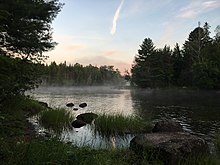Saint Croix River (Maine – New Brunswick)
| St. Croix River | |
|---|---|

St. Croix River at
Vanceboro, Maine. |
|
| Country | Canada/United States |
| Basin features | |
| Main source | Chiputneticook Lakes |
| River mouth |
Passamaquoddy Bay sea level 45°04′23″N 67°05′35″W / 45.073°N 67.093°WCoordinates: 45°04′23″N 67°05′35″W / 45.073°N 67.093°W |
| Basin size | 1,500 square miles (3,900 km2) |
The St. Croix River is a river in northeastern North America, 71 miles (114 km) in length, that forms part of the Canada–United States border between Maine (U.S.) and New Brunswick (Canada). The river rises in the Chiputneticook Lakes and flows south and southeast, between Calais and St. Stephen. It discharges into Passamaquoddy Bay, in the Bay of Fundy.
The river forms from the Chiputneticook Lakes (North Lake, Grand Lake, Mud Lake, and Spednic Lake) along the Canadian - U.S. border. U.S. Geological Survey topographic maps show the St. Croix River as beginning at the 1.0-mile-long (1.6 km) outlet stream from Grand Lake, then flowing through the short Mud Lake and entering Spednic Lake, extending 20 miles (32 km) to its outlet at Vanceboro, Maine, and the start of the river proper. Adding the section of river and lake from the outlet of Grand Lake gives a total length of 95 miles (153 km) to the St. Croix.
The total drainage area of the river is approximately 1,500 square miles (3,900 km2). In the 20th century, the river was heavily developed for hydroelectric power. The river had previously hosted a large population of Atlantic salmon; however, the salmon population was reduced after building hydroelectric dams upriver from Calais-St. Stephen.
The river is an estuary between Calais-St. Stephen and the river's mouth at Robbinston and St. Andrews. This tidal area extends for approximately 16 miles (26 km) along this section and exhibits a tidal bore.
The Saint Croix River was an early trade corridor to interior Maine and New Brunswick from the Atlantic coast. Ocean ships could navigate upstream to Calais and St. Stephen; although tidal fluctuation made Eastport a preferred port for deeper draft vessels. The river upstream of Calais and St. Stephen became an important transportation corridor for log driving to bring wooden logs and pulpwood from interior forests to sawmills and paper mills built to use water power at Calais and Woodland.
...
Wikipedia
